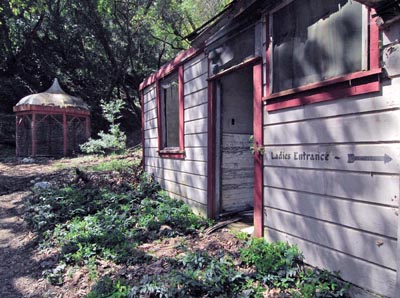
Getting Out: Walking alone across the Gilroy Hot Springs
property, I felt the powerful presence of those that had been there
many years before. It was almost as if I were an unwelcome intruder
invading the privacy of spirits that linger there. There are
cabins, bathhouses and other buildings that still stand, but
withered daffodils and little planting areas behind small stacks of
stones tell of intimate moments of care and cultivation done by
long gone souls.
Walking alone across the Gilroy Hot Springs property, I felt the powerful presence of those that had been there many years before. It was almost as if I were an unwelcome intruder invading the privacy of spirits that linger there. There are cabins, bathhouses and other buildings that still stand, but withered daffodils and little planting areas behind small stacks of stones tell of intimate moments of care and cultivation done by long gone souls.
George Roop purchased the hot springs property in 1866. By the mid-1870s, he had built a three story hotel and a clubhouse to accommodate visitors who came to enjoy the benefits of “the finest springs in the state.” Roop sold the property to William and Emily McDonald in the 1920s who turned things up a notch. They added cabins to handle the 500 visitors a day that came during peak season. This was the roaring twenties and Gilroy Hot Springs offered slot machines, poker games, Saturday night dances and a discreet place to sip forbidden hooch.
In 1938, Kyuzaburo Sakata purchased the hot springs to create a restful retreat for Japanese Americans. After World War II, Sakata returned from forced internment and opened the hot springs as a transitional shelter to Japanese American families who, after the loss of their homes and possessions, had nowhere to go. Today, Gilroy Hot Springs is a California Historical Landmark and is on the National Register of Historic Places. In 2003, the property was purchased by the California Department of Parks and Recreation and was added to Henry Coe State Park, but until recently little has been done to restore the site.
Laura Dominguez-Yon has deep roots in Gilroy Hot Springs. Her family managed the resort from the late 1940s into the 1950s and her uncle was the spiritual leader there until 1971. She spent many childhood weekends at the hot springs romping across the hills. Recently, her efforts have brought together former hot springs residents, their descendents and other interested people who have formed Friends of Gilroy Hot Springs (FOGHS). Their hope is to build an organization that will protect and restore this special place and open it again to public use.
That process is already underway. For years, Gilroy Hot Springs has been closed. But Friends of Gilroy Hot Springs has begun a series of events and activities that gives people a chance to visit as well as help with work that needs to be done there. Saturday, May 14 is their “Walk Through History” Day. Bring a picnic lunch and enjoy a day of docent led tours, live music, and fun for a $5 cost (Kids under 12 are free). Make reservations at the FOGHS website.
They also have scheduled a number of Full Moon Campouts throughout the summer. In exchange for a little volunteer work (brush clearing, path maintenance, etc.) and a small fee, you can camp for the weekend at the hot springs. Check the website for dates and details.
The vitality of the history at Gilroy Hot Springs will surprise you. And yes, warm water still percolates to the surface from some subterranean hot spot. Take one of these opportunities to visit, and perhaps this special place will excite you as well. You’ll want to join FOGHS and support their efforts to resurrect Gilroy Hot Springs.
Reminder: Join me Saturday, April 23 for a great 4-mile hike over the Mummy Mountain Trail at Harvey Bear Ranch County Park. Meet at 9 a.m. at the Mendoza Ranch entrance (From the Gilroy Outlets, go two miles east on Leavesley Road, turn left on New Avenue, right on Roop Road, then 3 1/2 miles). See you there.









